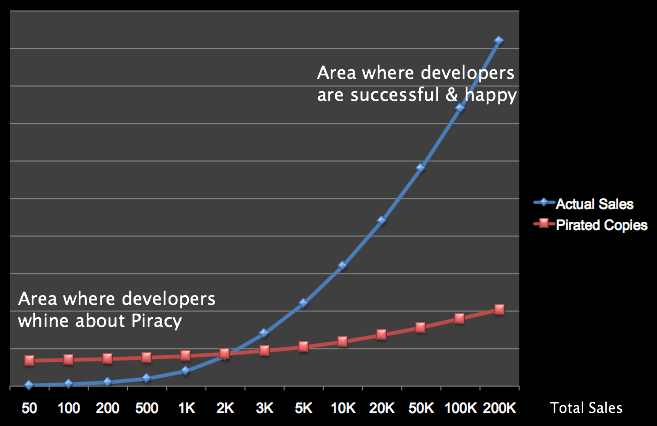Looking for a Sprite Kit Game Engine? Check out Kobold Kit!
Two weeks ago I blogged about Why Apple Created Sprite Kit and What It Means For Cocos2D.
Two weeks since WWDC 2013 is also a good time to take a first look at the impact of Sprite Kit on the economy. Everything and everyone seems to be in turmoil right now as far as 2D game development for iOS and related tools and services is concerned.
To understand the impact of Sprite Kit, let’s first look at Kobold Touch for which I have actual data to back up my impressions.
KoboldTouch Signup Rate - Bummer!
I have been taking notes of the exact days new KoboldTouch users signed up in an Excel sheet. I found it entertaining and thought that maybe some day I will have a use for it.
That day has come. I can present you the KT sign up rate from post-WWDC dates June 10th to 24th with the sign-up rate of the same two-week span in the preceding months: Continue reading »
KoboldTouch has been on sale for exactly 5 months (released: Nov 1st, 2012). Time for a “numbers post”.
Let’s start with new user signup rates and popular pricing plans before I get to reveal actual and projected revenues.
New User Signup Rate
With a build-up of anticipation, the first month is always noticably on the positive side. If you ignore that first month, you’ll notice that signup rate has been very steady from December through February when it suddenly doubled in March.
This chart shows the number of new users who signed up to any of the pricing plans, with refunds already deducted:
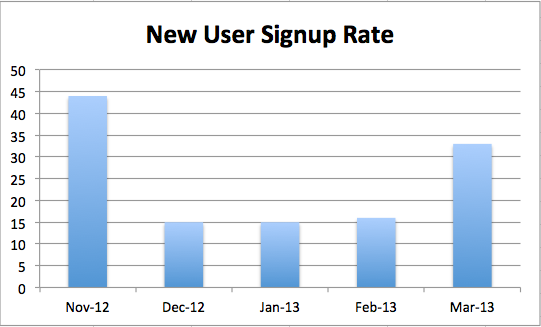
The actual “new user” numbers (not including refunds) for each month are:
- Nov 12: 44
- Dec 12: 15
- Jan 13: 15
- Feb 13: 16
- Mar 13: 33
I believe the reason for the influx of new users in March is two-fold: first I introduced the 1-Month billing plan in Mid-February. And around the same time frame I started hosting the KoboldTouch documentation and KoboldTouch Sales Pitch on www.koboldtouch.com. Continue reading »
 While I did the year’s end reports on practically everything, I also ran the numbers on KoboldTouch.
While I did the year’s end reports on practically everything, I also ran the numbers on KoboldTouch.
Now that it’s been available for just over two months, I decided to make the $39.95 plan available for everyone which was previously only available to Learn Cocos2D 2 book owners. This plan replaces the $44.95 plan.
The “3-months only” plan is now also down from $44.95 to $39.95.
Please take the KoboldTouch survey. I highly appreciate your feedback, thank you!
With actual sales figures of the past two months I could see a clear pattern: Continue reading »
It isn’t piracy! … Not even close.
I have a problem with terms that are not clearly defined. Words like “much”, “a lot” or as in this case: “unbelievably high”. If you argue that the problem with Android is its high piracy rate based on one developer’s subjective statement and general hearsay, it’s not an argument.
Before I get to debunk why piracy can’t be that big an issue for Android developers, allow me to restate which developers regularly complain about piracy to begin with. There always seems to be the issue that low selling apps see a much larger percentage of pirated copies being used than high volume apps. This is because some pirates download and try out almost everything that’s available just because they can.
Interestingly, the badly selling app developers seem to be those who complain the most about piracy. Because it’s so easy to blame a failure to sell on piracy. See this fictive graph:
This is just a quick report that my recent efforts on Kobold2D and on other fronts seem to be paying off. I looked at the sales of my Line-Drawing Starterkit over the past couple months, and I noticed a pleasant trend:
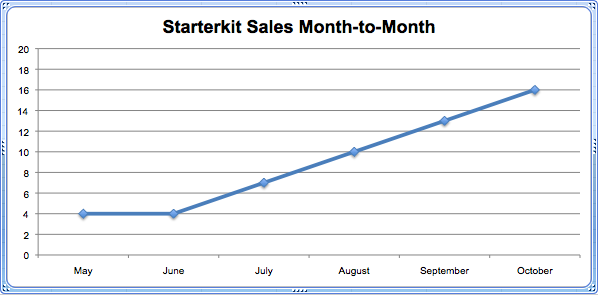
Many thanks to all supporters and customers! Continue reading »
Update: please find the iOS Device Sales Statistics for Q1 2012 here.
Currently Cocos2D is being overhauled for a v2.0 release. It will only support OpenGL ES 2.x and thus games made with Cocos2D v2.x will not run on 1st & 2nd generation devices (iPhone, iPhone 3G, iPod Touch 1 & 2).
The two development threads in the Cocos2D forum here and here are full of users expressing their disappointment (among other emotions/criticism) not to support a rendering core that supports both GL ES 1.x and 2.x. Even though it was said that if you still need to support all devices, you can simply continue to use the Cocos2D v1.x branch.
I’ve run some numbers and came to the following conclusion: if your game only supports OpenGL ES 2.x and comes out in Q1 2012, you will lose less than 10% of customers!
Here’s why I think OpenGL ES v1.x is currently in the process of dropping dead, and close to hitting the ground within the coming ~6 months.
iPhone Sales Statistics Q1 2011
Wikipedia has a nice list of iPhone sales statistics (totals) as they were reported by Apple each quarter. These statistics range from Q3 2007 to Q1 2011. Unfortunately, sales by Apple are not reported by device, so some quarterly sales are combined sales of iPhone 3G + iPhone 3GS respectively iPhone 3GS + iPhone 4.
I tried to extrapolate individual device sales by making the assumption that over time periods where two different iPhone devices were being sold, the newer one was likely to have sold more. Since we’re talking about Apple I choose a 70/30 split, meaning I assumed that 70% of the sales were for the newer device. This seems about right since newer devices have always sold better than the previous generation, but also according to some developer statistics.
For example the Bump developers reporting an iOS 4 adoption rate of 90% in January 2011 across all iOS devices (1st generation devices can not install iOS 4). Or the Surgeworks iOS 4 Adoption report which contains usage statistics of 1st generation device users of only 2.5% for one app, and 5% iPhone 3G users for another app.
The left side of the following pie charts shows the total number of iPhone devices sold to that date, with sales periods of two devices combined. The pie charts on the right show the extrapolated sales statistics for individual iPhone device generations, and which OpenGL ES version they support.
Download the Excel sheet I used to create these charts: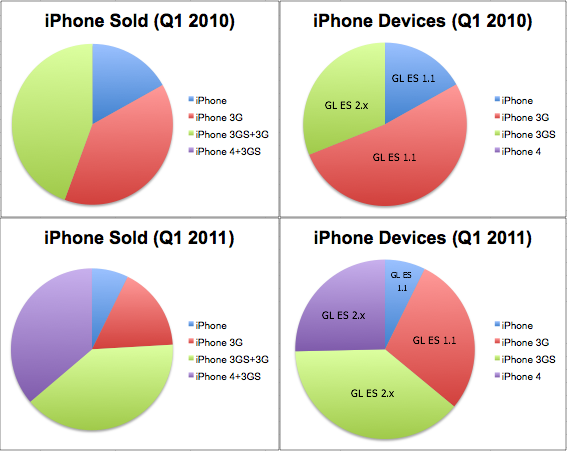
Notice how in Q1 2010 about two third of all iPhone devices supported only OpenGL ES 1.x, but within a year the picture turned just the other way. In Q1 2011 two thirds of iPhone devices sold were capable of running OpenGL ES 2.x code!
This has a lot to do with two factors: the iPhone 4 sold like crazy, whereas the last OpenGL ES 1.1 iPhone being sold (iPhone 3G) was discontinued in June 2010. Meaning since Q3 2010 Apple does no longer sell OpenGL ES 1.1 iPhone devices. And OpenGL ES 1.1 iPod Touches stopped selling in Q4 2010 as well.
All iOS Device Sales Statistics Q2 2011
According to Unwired, Apple reported to have sold 200 million iOS Devices during the iOS 5 announcement. 25 Million of those were iPads. These are the most up to date sales stats, which I assume to be the Q2 2011 statistics.
Based on Wikipedia’s numbers which states 83 Mio. iPhone devices sold vs. over 60 Mio. iPod Touch devices sold, the remaining 175 Mio. should be 42% iPod Touch (74 Mio) and 58% iPhone (102 Mio).
The percentage of OpenGL ES 2.x capable iPhone devices to those only supporting OpenGL ES 1.1 was 31% in Q1 2010 and jumped to 64% in Q1 2011. Assuming the 1.1 to 2.x ratio is the same for iPod Touch, that gives us 137 Mio iOS devices (iPhone, iPod Touch, iPad) with OpenGL ES 2.x capability versus 63 Mio devices (1st & 2nd generation iPhone / iPod Touch) which don’t support 2.x.
This pie chart includes all iOS Devices and which OpenGL ES version they support: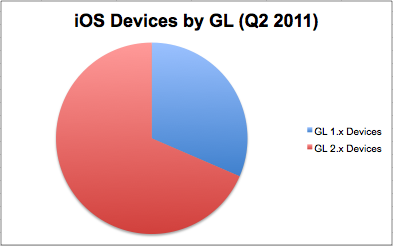
That means 70% of all iOS devices sold to date support OpenGL ES 2.x. This leaves us with only 30% of iOS devices not capable of running OpenGL ES 2.x code.
I don’t want to lose 30% of my customers!
You won’t!
Keep in mind that these statistics are only about devices sold. They do not reflect what has happened to these devices since, or how they are being used today.
I can also assert that older devices are disappearing fast from the market. Even though 30% of the devices sold support only OpenGL ES 1.1, your potential customer base will be significantly less than the number of devices sold. This is for a variety of reasons:
- device has been lost or was stolen
- device broken beyond use/repair
- device simply no longer in use
- device owned by a person who is unlikely to buy new apps
Particularly the last item must be considered: the device user. Again, the user is your potential customer, not the device. And in general all of these items are more likely to happen the older the device is.
One commenter in one of the two GL ES 2.0 threads on the Cocos2D forum reported how happy users were to see a game running smoothly on their 1st generation devices. For me that is not proof that support for older devices is beneficial. To the contrary, I think it clearly shows us that old generation device users are much more selective about their purchases, are already giving up their love for their devices, and may be considering an upgrade because they may have stopped enjoying their devices. This contributes to the “less likely to buy new apps” factor.
You can also assume that users of older devices have less expendable income, or are satisfied with the device as it is. If a user is actually happy with an old iOS device, it’s likely that person prefers to use apps and plays few(er) games or just keeps using the apps & games already owned.
The number of potential customers you would lose - if you released an OpenGL ES 2.0 game right now - is maybe around 10% to 20% at most. Far less if your game is complex and visually rich, and would suffer some performance or visual degradation on older devices anyway.
What about the near future? (Q1 2012)
Considering that 6 months from now, in Q1 2012, we will have seen the release of new iPhone devices (iPhone 5, possibly iPod 5) and thus another boom in sales, it is a better deal to start making some cool visual effects with shaders that look great on iPhone 4 and 5 rather than trying to still support 1st and 2nd generation devices.
In particular if you need to put in some (or a lot of) effort to support the older devices, for example if you have to optimize the performance, reduce the feature set (eg no or limited Game Center support) or (god forbid) you need to ensure compatibility with iOS 3.0.1 or lower (CADisplayLink unavailable!). That time and effort are better spent on making a better OpenGL ES 2.x game!
Obviously the decision also depends on how visually rich your game is going to be and whether you can expect to run into performance and other issues on older devices anyhow.
Summary
I fully expect the market share of OpenGL ES 1.1 devices sold to drop to around 20% by Q1 2012. That puts the number of potential customers (for game developers) still using those devices and buying games to certainly much less than 10%. Then consider that the iPhone 5 may even already account for up to 5% (~10 Mio) of all iOS devices sold by Q1 2012.
By the end of 2012 the potential customer base (for game developers) still using 1st and 2nd generation devices will have become entirely negligible.
That means, if you start developing an OpenGL ES 2.x game within the next 3 months, and your game takes 3+ months to complete, you will lose very few customers by only supporting 3rd generation and newer devices. And you may actually be able to win more customers by cleverly supporting the new devices!
I think it’s wise to start using Cocos2D v2.0 as soon as it is production-ready, which may be in around 3-6 months according to the comments and current progress.
Game On, Cocos2D 2.x!
One of my book readers, Jim, asked me an interesting question. Not about the book but about the Cocos2D Central community website that I’ve installed a few weeks ago. I thought the answers to his questions are of interest to others even though it doesn’t exactly fit the Cocos2D theme of this website. Jim was asking:
(1) Why did you choose IP.Board over something like phpbb or vBulletin and (2) after having it for a while, would you recommend it to others?
(1) Why I chose IP.Board
The initial starting point of my search was the fact that bbPress sucks. That’s my professional assessment, believe it or not. Well, no, don’t believe that, it’s actually a quite nice forum if you are already hosting a WordPress website and you want a forum that integrates well and won’t be receiving much traffic. But as I’m sure many can relate, the bbPress forum software doesn’t scale very well.
But more importantly I wanted a forum that is able to factor in popularity and relevance of posts in searches, and searches over all the content (eg. the wiki area) not just posts. One that allows users to subscribe to threads and forums and receive email notifications. One that makes embedding code and media easy using the most common forum syntax bbCode. One that allows to extract the helpful and relevant articles from threads so they don’t become buried in the thread. One that allows attachments and signatures, which users could use to promote their Website, App, Product, themselves and what not. One that integrates well with social networks, one that let’s you like things, tweet posts and allow users to sign up with their existing Twitter, Facebook or OpenID accounts.
The usual candidates
Primary candidates were of course vBulletin and phpBB which I’ve both used in the past. Especially vBulletin was the first one I looked at but then I learned two things: for one it’s a rather expensive one-time payment of $285 for the full publishing suite, and $195 still for only the forum. And then at least two or three users mentioned that their support or the stability of the software recently went south with version 4. That was enough to let me look around for possible alternatives. I can’t say if version 4 is really that bad and the rumors are true, but I haven’t looked back since.
Beginning my search I quickly came across the Forum Software Reviews website. This was initially very helpful to find out about all the various options that exist - and wow, the forum software market is crowded indeed. It was also clear that there was almost no “free” option I could seriously consider. The free forums fell off the grid in two or three categories: they either lacked critical features or they had an impressive feature set but oh boy was it ugly to look at and confusing to use. The third category was when “free” wasn’t really free and there was a strong upsell to the commercial version, respectively on the downside having to rely on voluntary support.
The phpBB software was my second choice in line. Oh yes, it’s free and rather complete but, like I said, I worried about support. I also wasn’t impressed by its look and feel at all. It’s hard to tell but … I don’t know, it simply looks cheap and noisy to me. I would certainly prefer the admittedly clean and noiseless look of bbPress. I then came across FreeForums.org which are offering a polished version of phpBB and they also host it for you for a small fee. But ultimately I was turned off by the fact that it was still phpBB and still ugly, and they are charging for features I don’t feel comfortable paying for. $10 per year for the removal of the Copyright notice in the footer? $5 per month to remove the ads? $30 per year to allow me to use the recovery console? Some features I pay monthly, some every 6 months and the rest yearly? Come on. Give it to me straight. And I want to pay for features I’m getting, not to disable “features” I don’t want and quite honestly, are nothing but a checkbox in their customer database. If that’s the attitude of the company when it comes to selling, how is their attitude towards supporting me going to be? I decided I didn’t want to find out.
IP.Board to the rescue
A few people mentioned IP.Board and even though I skipped it at first, and when I checked it out the first time it didn’t seem like a good fit and more likely to be overkill. Still, after coming back to the website several times, I went ahead and tried it. That’s when all the powerful options dawned on me: what if, instead of adding just a forum and integrating it with the Learn Cocos2D website, what if I made something bigger?
That’s also when the idea for the name “Cocos2D Central” and - being prepared for the future - “GameDev Central” came to be. An external community website that eventually would be the backend for the Learn Cocos2D blog. It made me think about moving everything over to IPS, except for the intro and the blog. I would be able to move my store over to IPS. I liked the IP.Downloads product because managing downloads is “blegh” in WordPress. And generally I could do much, much more to build and grow a community with all the neat social features that are built in.
I quickly decided to start with the Standard 25 plan for $20 per month. It was minimal risk because there’s no minimum duration you sign up for. And I quickly added IP.Content and then upgraded to Plus 40 because I wanted to be able to use IP.Nexus, the eCommerce addon. I’m now paying $35 per month to Invision Power and gladly so. I couldn’t be happier with their Hosted Community offer. I could have bought the products, installing and administering them myself, but that task seemed daunting and if I learned anything: services that are good are worth paying for. My time is better spent coding than managing the server, website and forum.
(2) Would I recommend it?
Definitely a resounding yes!
What really blew me away was the level of support given by Invision Power Services Inc. They are the Zappos of community software! Both on their forum and via tickets, they respond fast and I haven’t seen a post that didn’t receive a reply. They do make you feel welcome and supported.
There were a few minor hickups. Shortly after signing up Cocos2D Central experienced frequent downtimes from 10 to 45 minutes each, sometimes several times a day. I asked them about that and they were quite forthcoming to answer this question: communities are hosted on virtual servers, so several communities share the same hardware. If a community gets hacked or attacked or simply flooded with requests (Slashdot effect or a DOS) they are moving the affected community to a new server. As I understood it they were in the general process of splitting communities based on the nature of their content, so that those communities more likely to be receiving attacks will be hosted on different servers, so that communities with “regular content” won’t be affected. The downtimes still happen but are now much less frequent and shorter.
How do I know? I monitor the website via Pingdom, which alerts me via email when Cocos2D Central goes down and when it comes back online, in 5 minute intervals.
So overall, I can certainly recommend the Invision Power Services. And just so you know, I wrote this post without any affiliation, I don’t receive any money or other benefits from them for writing this. I’m simply a fan and hopefully for a long time I will be a very happy customer too.
WasabiSoft published a very insightful 3-part guide for supporting your App Store customers, and serving them right:
Support Series Part I: Top DON’Ts for your App Store support link



